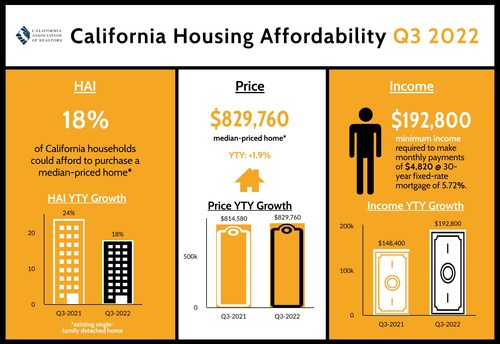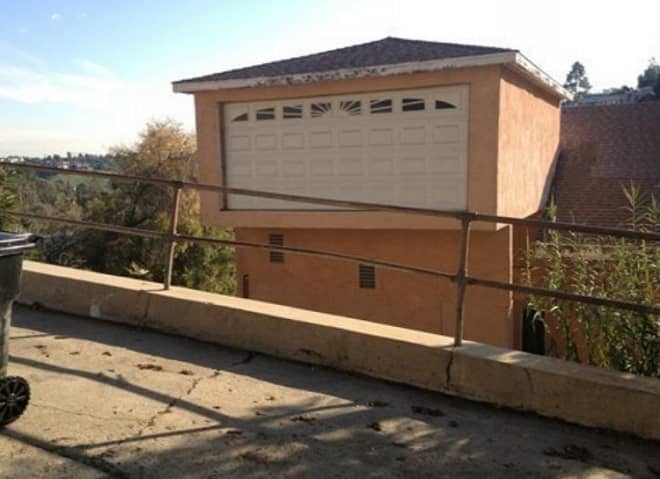- Eighteen percent of California households could afford to purchase the $829,760 median-priced home in the third quarter of 2022, up from 16 percent in second-quarter 2022 but down from 24 percent in third-quarter 2021.
- A minimum annual income of $192,800 was needed to make monthly payments of $4,820, including principal, interest and taxes on a 30-year fixed-rate mortgage at a 5.72 percent interest rate.
- Nearly 30 percent (27 percent) of California home buyers were able to purchase the $630,000 median-priced condo or townhome. A minimum annual income of $146,400 was required to make a monthly payment of $3,660.
- Infographic: https://www.car.org/Global/Infographics/HAI-2022-Q3
Los Angeles, CA – Nov. 11, 2022 (PRNewswire) Housing affordability in California bounced back in the third quarter with the statewide index for existing single-family home sales inching up to 18 percent after hitting a 15-year low of 16 percent in the second quarter of 2022, the CALIFORNIA ASSOCIATION OF REALTORS® (C.A.R.) said today.
The percentage of home buyers who could afford to purchase a median-priced, existing single-family home in California in third-quarter 2022 rose slightly to 18 percent from 16 percent in the second quarter of 2022 but was down from 24 percent in the third quarter of 2021, according to C.A.R.’s Traditional Housing Affordability Index (HAI). California hit a peak high affordability index of 56 percent in the first quarter of 2012.
C.A.R.’s HAI measures the percentage of all households that can afford to purchase a median-priced, single-family home in California. C.A.R. also reports affordability indices for regions and select counties within the state. The index is considered the most fundamental measure of housing well-being for home buyers in the state.
A minimum annual income of $192,800 was needed to qualify for the purchase of a $829,760 statewide median-priced, existing single-family home in the third quarter of 2022. The monthly payment, including taxes and insurance on a 30-year, fixed-rate loan, would be $4,820, assuming a 20 percent down payment and an effective composite interest rate of 5.72 percent. The effective composite interest rate was 5.39 percent in second-quarter 2022 and 3.07 percent in third-quarter 2021. In anticipation of the Fed’s strong push on rate increases in the past few months, the market continued to put upward pressure on yields which resulted in the average 30-year fixed-rate mortgage (FRM) reaching the highest level in 20 years in late September.

The median price of existing single-family homes in California experienced the largest quarter-to-quarter decline in price since the first quarter of 2011. Despite the sizable quarter-to-quarter drop in median price, the share of households in California that could afford to buy a median-priced condominium or townhome continued to slide from last year as the cost of borrowing remained high.
Twenty-seven percent of California households earned the minimum income to qualify for the purchase of a $630,000 median-priced condo/townhome in the third quarter of 2022, which required an annual income of $146,400 to make monthly payments of $3,660. The third quarter 2022 figure was down from 37 percent a year ago.
Nationwide housing affordability also plunged in third-quarter 2022. Compared with California, 39 percent of the nation’s households could afford to purchase a $398,500 median-priced home, which required a minimum annual income of $92,400 to make monthly payments of $2,310. Nationwide affordability was 50 percent a year ago.
Key points from the third-quarter 2022 Housing Affordability report include:
- Compared to the previous quarter, housing affordability in the third quarter of 2022 improved in 40 counties and remained unchanged in four counties. All but two counties decreased in housing affordability from a year ago, with Tehama being the only county with an increase from last year and San Mateo County remaining unchanged at 19 percent year-over-year.
- In the nine-county San Francisco Bay Area, affordability improved from the previous quarter in all counties except Napa County, which declined 2 percent.
- In the Southern California region, housing affordability increased in all counties except Los Angeles County where affordability declined to 13 percent compared with 16 percent in second quarter 2022. San Bernardino County was the most affordable in the region at 31 percent of households able to purchase the $480,000 median-priced home. However, San Bernardino County also had the third largest year-over-year dip declining 12.7 percent.
- In the Central Valley region, Kings County was the most affordable at 40 percent, and San Benito was the least affordable at 20 percent.
- In the Central Coast region, Santa Barbara County was the least affordable at 12 percent, and Santa Cruz County was the most affordable at 14 percent.
- For the state as a whole, Lassen (56 percent) remained the most affordable county in California in the third quarter of 2022, followed by Kings (40 percent), Shasta (39 percent) and Tehama (39 percent). Lassen also had the lowest minimum qualifying income ($56,800) of all counties in California to purchase a median-priced home and was the only county in the state with a qualifying income less than $60,000.
- Mono (8 percent) and Santa Barbara (12 percent) were the least affordable counties in California, with each requiring at least a minimum income of $197,200 to purchase a median-priced home in the county. San Mateo ($448,400) continued to have the highest minimum qualifying income over more than $400,000 required in the third quarter of 2022. Other counties with minimum qualifying income just slightly below $400,000 included Marin ($394,800), Santa Clara ($392,000) and San Francisco ($385,200).
- Housing affordability declined the most on a year-over-year basis in Kings, falling 16.2 points year-over-year. Mariposa (13.7 points) and San Bernardino (12.7 points) had the second and third largest year-over-year dips. The surge in mortgage rates, along with elevated home prices, continued to be the primary factors for the plunge in affordability in these counties.
See C.A.R.’s historical housing affordability data.
See first-time buyer housing affordability data.
Leading the way…® in California real estate for more than 110 years, the CALIFORNIA ASSOCIATION OF REALTORS® (www.car.org) is one of the largest state trade organizations in the United States with more than 217,000 members dedicated to the advancement of professionalism in real estate. C.A.R. is headquartered in Los Angeles.
| CALIFORNIA ASSOCIATION OF REALTORS® Traditional Housing Affordability Index Third quarter 2022 | ||||||||
| Q32022 | C.A.R. Traditional Housing Affordability Index | |||||||
| STATE/REGION/COUNTY | Q32022 | Q22022 | Q32021 | Median Home Price | Monthly Payment Including Taxes & Insurance | Minimum Qualifying Income | ||
| CA SFH (SAAR) | 18 | 16 | 24 | $829,760 | $4,820 | $192,800 | ||
| CA Condo/Townhomes | 27 | 25 | 37 | $630,000 | $3,660 | $146,400 | ||
| Los Angeles Metropolitan Area | 19 | 17 | 26 | $765,000 | $4,440 | $177,600 | ||
| Inland Empire | 25 | 24 | 36 | $567,000 | $3,290 | $131,600 | ||
| S.F. Bay Area | 20 | 18 | 22 | $1,265,000 | $7,340 | $293,600 | ||
| US | 39 | 38 | 50 | $398,500 | $2,310 | $92,400 | ||
| S.F. Bay Area | ||||||||
| Alameda | 17 | 15 | 19 | $1,260,000 | $7,310 | $292,400 | ||
| Contra Costa | 25 | 22 | 31 | $886,250 | $5,140 | $205,600 | ||
| Marin | 18 | 17 | 22 | $1,700,000 | $9,870 | $394,800 | ||
| Napa | 13 | 15 | 23 | $1,100,000 | $6,380 | $255,200 | ||
| San Francisco | 20 | 17 | 21 | $1,660,000 | $9,630 | $385,200 | ||
| San Mateo | 19 | 15 | 19 | $1,931,000 | $11,210 | $448,400 | ||
| Santa Clara | 20 | 18 | 22 | $1,688,000 | $9,800 | $392,000 | ||
| Solano | 30 | 28 | 42 | $595,000 | $3,450 | $138,000 | ||
| Sonoma | 19 | 17 | 28 | $825,000 | $4,790 | $191,600 | ||
| Southern California | ||||||||
| Los Angeles | 13 | 16 | 19 | $893,230 | $5,180 | $207,200 | ||
| Orange | 13 | 12 | 18 | $1,200,000 | $6,960 | $278,400 | ||
| Riverside | 23 | 21 | 33 | $615,000 | $3,570 | $142,800 | ||
| San Bernardino | 31 | 30 | 43 | $480,000 | $2,790 | $111,600 | ||
| San Diego | 15 | 14 | 23 | $900,000 | $5,220 | $208,800 | ||
| Ventura | 17 | 15 | 25 | $887,000 | $5,150 | $206,000 | ||
| Central Coast | ||||||||
| Monterey | 13 | 13 | 20 | $850,000 | $4,930 | $197,200 | ||
| San Luis Obispo | 13 | 12 | 24 | $875,000 | $5,080 | $203,200 | ||
| Santa Barbara | 12 | 10 | 17 | $1,010,000 | $5,860 | $234,400 | ||
| Santa Cruz | 14 | 13 | 17 | $1,255,000 | $7,280 | $291,200 | ||
| Central Valley | ||||||||
| Fresno | 32 | 31 | 42 | $410,000 | $2,380 | $95,200 | ||
| Glenn | 34 | 36 | 44 | $335,000 | $1,940 | $77,600 | ||
| Kern | 34 | 32 | 45 | $368,000 | $2,140 | $85,600 | ||
| Kings | 40 | 39 | 56 | $335,000 | $1,940 | $77,600 | ||
| Madera | 34 | 32 | 43 | $410,000 | $2,380 | $95,200 | ||
| Merced | 34 | 34 | 44 | $395,000 | $2,290 | $91,600 | ||
| Placer | 30 | 27 | 38 | $664,000 | $3,850 | $154,000 | ||
| Sacramento | 29 | 27 | 39 | $535,000 | $3,100 | $124,000 | ||
| San Benito | 20 | 17 | 27 | $775,000 | $4,500 | $180,000 | ||
| San Joaquin | 29 | 26 | 37 | $520,000 | $3,020 | $120,800 | ||
| Stanislaus | 30 | 28 | 41 | $460,000 | $2,670 | $106,800 | ||
| Tulare | 36 | 34 | 46 | $355,000 | $2,060 | $82,400 | ||
| Far North | ||||||||
| Butte | 30 | 28 | 35 | $441,000 | $2,560 | $102,400 | ||
| Lassen | 56 | 54 | 68 | $244,950 | $1,420 | $56,800 | ||
| Plumas | 28 | 32 | 38 | $447,500 | $2,600 | $104,000 | ||
| Shasta | 39 | 36 | 44 | $375,000 | $2,180 | $87,200 | ||
| Siskiyou | 31 | 30 | 41 | $350,000 | $2,030 | $81,200 | ||
| Tehama | 39 | 33 | 38 | $309,250 | $1,790 | $71,600 | ||
| Other Counties in California | ||||||||
| Amador | 34 | 32 | 42 | $419,000 | $2,430 | $97,200 | ||
| Calaveras | 32 | 29 | 39 | $460,000 | $2,670 | $106,800 | ||
| Del Norte | 27 | 31 | 35 | $383,450 | $2,230 | $89,200 | ||
| El Dorado | 27 | 24 | 35 | $645,000 | $3,740 | $149,600 | ||
| Humboldt | 23 | 24 | 32 | $470,000 | $2,730 | $109,200 | ||
| Lake | 33 | 33 | 42 | $339,000 | $1,970 | $78,800 | ||
| Mariposa | 21 | 22 | 35 | $449,000 | $2,610 | $104,400 | ||
| Mendocino | 18 | 15 | 23 | $543,250 | $3,150 | $126,000 | ||
| Mono | 8 | 6 | 13 | $850,000 | $4,930 | $197,200 | ||
| Nevada | 25 | 25 | 35 | $579,450 | $3,360 | $134,400 | ||
| Sutter | 32 | 31 | 42 | $445,000 | $2,580 | $103,200 | ||
| Tuolumne | 35 | 33 | 45 | $410,000 | $2,380 | $95,200 | ||
| Yolo | 24 | 23 | 33 | $635,000 | $3,680 | $147,200 | ||
| Yuba | 29 | 27 | 38 | $431,500 | $2,500 | $100,000 |
r = revised
Traditional Housing Affordability Indices (HAI) were calculated based on the following effective composite interest rates: 5.72% (3Qtr. 2022), 5.39% (2Qtr. 2022) and 3.07% (3Qtr. 2021).
SOURCE CALIFORNIA ASSOCIATION OF REALTORS® (C.A.R.)




